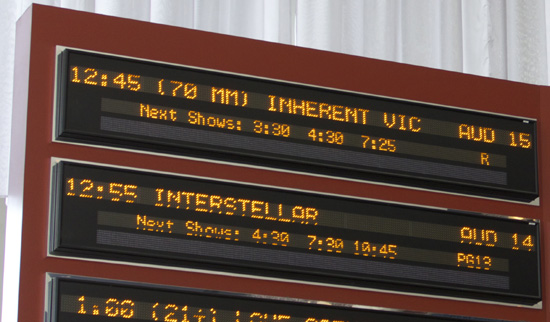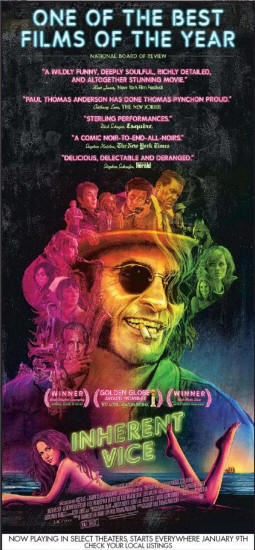Is it possible that there is still life in the 70mm format? |
Read more at in70mm.com The 70mm Newsletter |
| Written by: Bill Kallay, Hollywood, USA | Date: 19.12.2014 |
 The
proof came in Paul Thomas Anderson’s film,
"Inherent Vice"
in
December 2014. The film was released in 70mm, with two prints playing at the
ArcLight Cinemas and Cinerama Dome in Hollywood, California. The
proof came in Paul Thomas Anderson’s film,
"Inherent Vice"
in
December 2014. The film was released in 70mm, with two prints playing at the
ArcLight Cinemas and Cinerama Dome in Hollywood, California. I have never been a particular fan of Anderson’s films, though I was impressed with the ambitious, yet flawed, “Boogie Nights” (1997). The film borrowed heavily from the style of Martin Scorsese. “There Will Be Blood” (2007), left me cold despite my admiration for parts of the film. What I have always admired about Anderson has been his decision to shoot in different film formats. In many of his earlier films, he chose anamorphic widescreen, despite most films of the era being shot in either flat 1.85:1 or “Super 35.” The anamorphic frame with its lens flairs and unique “bokeh” always made his films stand out visually. Which brings me to his latest film, “Inherent Vice” (2014). The film was released in 70mm. Who would have thought, in late 2014, that we could see brand new films in 70mm? |
More in 70mm reading: "Inherent Vice" is released in 70mm P T Anderson's "The Master" in System 65 in70mm.com's list of films blown up to 70mm New Book: "The Making of Tron" 26 Things Movies Taught You How to Create the Best experience in the Cinema Internet link: |
 Anderson,
at least for the time being, continues to embrace film as an artistic choice
when it comes to how his films are shot and released. It may be unusual in
the 21st century to release a movie in a film format, let alone 70mm.
Anderson has done it, and the result was surprisingly stunning. Anderson,
at least for the time being, continues to embrace film as an artistic choice
when it comes to how his films are shot and released. It may be unusual in
the 21st century to release a movie in a film format, let alone 70mm.
Anderson has done it, and the result was surprisingly stunning.In 2012, he surprised audiences by not only shooting most of “The Master?” in 65mm, but also by having it released in 70mm prints. Again, Anderson’s work is ambitious, but I found the film to be overlong and “artsy” for artistic sake. The film could have been shot on digital video and I would have felt the same way about it. All I know is that I was glad he embraced 65mm and had the guts to make the film in the format. Because of Anderson’s decision to shoot “The Master?” in 65mm, I was eager to see if he would shoot “Inherent Vice” the same way. To my disappointment, he did not. Instead, he chose to film in 35mm in the 1.85:1 aspect ratio. But he did have one trick up his sleeve; he would have 70mm prints released in select theaters. |
|
 Click
to see enlargement advert from LA Times - no mention of 70mm Click
to see enlargement advert from LA Times - no mention of 70mm“Inherent Vice” goes back to the age of the blow-up, whereby 35mm film was blown-up for 70mm presentation. The idea of 70mm blow-ups was to give audiences better picture and sound quality over that of standard 35mm. And from the 1960s through the early 1990s, the process worked and was very successful. By the early 1990s, digital sound supplanted the supposed “need” for 70mm prints. By 1999, digital projection supplanted the “need” for film prints. So why would Anderson chose to go back to blow-ups when there is “pristine” digital projection today? My thought is that Anderson grew up watching films on big screens with big sound during the 1970s and 1980s. He loved the look of film. He loved the organic film grain instilled in celluloid. After all, if you watch his films, they are very filmic in their structure and how everything is staged. I won’t go into too much detail about “Inherent Vice.” I will say that it’s an entertaining film and Anderson has clearly loosened up on being too serious. The film is lighthearted, if not a little slow, and the acting is well done. I laughed quite a few times and thought that Joaquin Phoenix commands the screen. I also enjoyed the sense that I felt like I was back in 1970 when the film take place. I was also reminded of how much I miss seeing 70mm in a large theatre. The 70mm print for “Inherent Vice” looked very good. There were some grainy shots and the smaller 35mm negative shows its limitations of film resolution. But so what? This was a film. The beauty of a 70mm print, despite the source, is that it holds Robert Elswit’s original cinematography intact with solid brightness, sharpness and color. Did “Inherent Vice” look as visually stunning as “The Master?” Cinematography wise, it was splendid. As far as resolution was concerned, it was not as sharp or dimensional, but it still looked excellent. As a fan of 70mm since childhood, I am happy to see it still thrive, albeit in small doses with the recent releases of “Interstellar” and “Inherent Vice.” |
|
| Go: back - top - back issues - news index Updated 22-01-25 |
